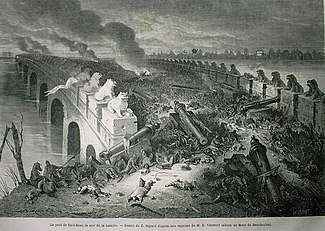
Back Tweede Opiumoorlog Afrikaans حرب الأفيون الثانية Arabic Segunda Guerra del Opiu AST İkinci tiryək müharibəsi Azerbaijani ایکینجی تریاک ساواشی AZB Икенсе әфиүн һуғышы Bashkir Другая опіумная вайна Byelorussian Втора опиумна война Bulgarian Segona Guerra de l'Opi Catalan Druhá opiová válka Czech
| Second Opium War | |||||||||
|---|---|---|---|---|---|---|---|---|---|
| Part of the Opium Wars | |||||||||
 Palikao's bridge, on the evening of The Battle of Palikao, by Émile Bayard | |||||||||
| |||||||||
| Belligerents | |||||||||
|
|
| ||||||||
| Commanders and leaders | |||||||||
|
| |||||||||
| Strength | |||||||||
|
7,400 [citation needed] (Eight Banners and Green Standard Army) | |||||||||
| Casualties and losses | |||||||||
|
| ||||||||
| 1 The U.S. was officially neutral, but later aided the British in the Battle of the Barrier Forts (1856) and the Battle of Taku Forts (1859).[3] | |||||||||
The Second Opium War (simplified Chinese: 第二次鸦片战争; traditional Chinese: 第二次鴉片戰爭), also known as the Second Anglo-Chinese War, the Second China War, the Arrow War, or the Anglo-French expedition to China, (simplified Chinese: 英法联军之役; traditional Chinese: 英法聯軍之役) [4][full citation needed] was a colonial war lasting from 1856 to 1860, which pitted Great Britain, France, and the United States against the Qing dynasty of China.
It was the second major conflict in the Opium Wars, which were fought over the right to import opium to China, and resulted in a second defeat for the Qing dynasty and the forced legalisation of the opium trade. It caused many Chinese officials to believe that conflicts with the Western powers were no longer traditional wars, but part of a looming national crisis.[5]
In 1860, British and French troops landed near Beijing at the Taku Forts, where they had fought for control twice before, and fought their way into the city. Peace negotiations quickly broke down and the British High Commissioner to China ordered the foreign troops to loot and destroy the Imperial Summer Palace, a complex of palaces and gardens at which Qing Dynasty emperors handled affairs of state.
During and after the Second Opium War, the Qing government was also forced to sign treaties with Russia, such as the Treaty of Aigun and the Convention of Peking. As a result, China ceded more than 1.5 million square kilometers of territory to Russia in its north-east and north-west. With the conclusion of the war, the Qing government was able to concentrate on countering the Taiping Rebellion and maintaining its rule.[6] Among other things, the Convention of Peking ceded the Kowloon Peninsula to the British as part of Hong Kong.
- ^ Frontier and Overseas Expeditions from India. Volume 6. Calcutta: Superintendent Government Printing. 1911. p. 446.
- ^ Wolseley, G. J. (1862). Narrative of the War with China in 1860. London: Longman, Green, Longman, and Roberts. p. 1.
- ^ Magoc, Chris J.; Bernstein, David (2016). Imperialism and Expansionism in American History. Volume 1. Santa Barbara, California: ABC-CLIO. p. 295. ISBN 978-1-61069-430-8.
- ^ Michel Vié, Histoire du Japon des origines a Meiji, PUF, p. 99. ISBN 2-13-052893-7.
- ^ Canada, Asia Pacific Foundation of. "The Opium Wars in China". Asia Pacific Curriculum. Retrieved 28 November 2021.
- ^ "The Second Opium War". Historic UK. Retrieved 28 November 2021.
© MMXXIII Rich X Search. We shall prevail. All rights reserved. Rich X Search